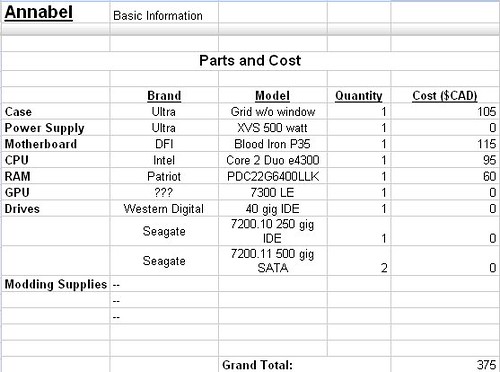New Server Build: Annabel!
I’m really miles deep into hardware now: A meager couple of months after completing my first ever custom build, I’m already starting another build, for a home server this time. Don’t be fooled by the term “home server”, this isn’t going to be a recycled P3 on Slot 1 in a fancy case sporting some big drives, it’s gonna pack some serious punch. Hell, it might even come close to making Fr0stbyte sweat on SuperPI runs.
The necessity for this box came from my dad shutting down the current server “Laggboxx” every night. Since I don’t like uploading torrents while I’m gaming for obvious reasons, night-time is the perfect time to get cracking at making my ratios better, and a closed server doesn’t seed a whole lot. I couldn’t open it in the morning either, so bottom line what was supposed to be a server spent more than half the time closed. Hurray for uptime.
This led me to want to build myself a server. I knew that I wanted something relatively cheap, but still something that could churn out decent work units and be quite futureproof, all while staying in the less than 700$ range, including storage drives. The key word in this whole thing was value: solid, quality used parts with good overclocking potential, and a fast yet cheap final product. After reading several build logs of such projects and/or dedicated folding boxes, I figured that my target price could yeild a pretty damn powerful machine. At the time that I wrote this article, the part’s list looked like this:
- CPU: Core 2 Duo "Allendale" e4300, 1.8 ghz stock
- Mobo: DFI Blood Iron P35
- RAM: ???
- Case: Ultra Grid with 500 XVS PSU
- Storage
- 40 gig Western Digital on IDE, OS and applications drive
- 250 gig Seagate 7200.10 on IDE, movies, install files, non-critical data, torrents, buffer NAS
- RAID 1 (mirrored) array of 2 Seagate 7200.11s on SATA, for music, media, important backups, stuff I really really want to keep.
And that’s pretty much it. Why these parts? Here comes the long part.
First, going with Intel was a sure thing. Not only because of fanboyism and because Intel kicks the shit out of everything else on the market, but also because I’m much more experienced at Intel overclocking, and I know a stable Intel OC when I see one. An AMD rig, even with the relatively new AM2 socket parts would have been much cheaper, but since my last AMD OC was horrible EPIC fail (I loled and wtfed at trying to lower DDR latencies, nowhere near DDR2), I decided it might be wise to shell out a bit more, get a bit more, and be more comfy with my stuff. The e2XXX series, commonly called Pentium Dual Cores, are known to be very good overclockers and generally retail for under 100$ dollars. I was looking for an e2180 (1.8 ghz, 9 x 200, 1 MB L2), which I’ve seen many times overclocked to as far as 3.5 ghz, but then an OCN member named Kopi posted his e4300 (1.8 ghz, 9 x 200, 2 MB L2), which is basically the same thing with more L2, so I jumped right on it. It has done 3.5 ghz on an older Intel P965 board, so getting it to 3 or 3.2 ghz on a more recent board is guaranteed to be easy.
Next, to attain and hold the high (at least considerably higher than stock) FSBs that I want to make this chip endure, I needed a solid board, while remaining in my mini-budget. I knew I wanted to go P35, but what I didn’t know is that I could get an overclocker’s favorite, the DFI Blood Iron, for just over 100$. As soon as I saw one on OCN, I snatched it.
As for the disk, I wanted to go Seagate because I’m a total fanboy, but I’m still hesitating between the classic 7200.10, the newer 7200.11 which are said to make some Raptors jealous and more solid server-grade drives the ES1’s.
The rest of the stuff is basically whatever I had handy or what I could get for cheap. The Patriot RAM I bought looks ok, some reviews are saying that they can do 1 000 mhz on CAS 5, which isn’t bad for something I paid 60$.
Total cost up to now?

Not bad for the price eh? All I’m missing is the discs now.
Be sure that I’ll post a couple of pictures once it’s done, but if you want more info, pictures, or a complete overview of my project check out the worklog hosted on the Overclock.net forums.